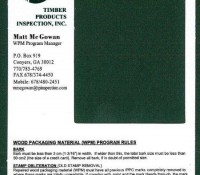Our Mission Statement
TP provides superior quality assurance programs and services to the forest products industry. This is accomplished by providing timely, cost effective services, thorough and accurate inspections, and exemplary customer service.
TP provides superior quality assurance programs and services to the forest products industry. This is accomplished by providing timely, cost effective services, thorough and accurate inspections, and exemplary customer service.

Bark cards are available upon request. Simply email drunner@tpinspection.com and provide your facility number, name, address and the number of cards you need and we will send these to you at no cost.
If we ever forget that we are One Nation Under God, then we will be a nation gone under.
Recorded volumes shipped for the month in the ISPM 15 program should include only the WPM or lumber that you marked during that month. In other words, any solid wood packaging product or lumber that you stamp with your IPPC, DUN or HT mark needs to be recorded as board footage shipped in your program. Anything that you do not mark should not be entered as part of your monthly volumes shipped for this program. The examples below are situations where you do not include the volumes shipped in your monthly shipping report:
The footage from any of this material should not be recorded in your ISPM 15 program shipped volumes.
If you build WPM from purchased HT lumber only and place your IPPC mark on it and also have a heat chamber where you treat and mark material with your IPPC mark as well, a separate record for volumes shipped for each situation needs to be kept. This is necessary to verify that the volume of WPM shipped which was totally produced from your purchased HT lumber does not exceed the volume of the purchased HT lumber you received.
If you purchase HT lumber and build WPM combining both HT and non-HT lumber and everything goes through your heat chamber before you put your IPPC mark on, it is not necessary to keep a record of the HT lumber you purchase since you are heat treating onsite all the WPM you are placing your IPPC mark on.
If your WPM is made partially from HT lumber and partially from exempt material and your mark is applied, only the footage of the HT lumber used in the manufacture of the WPM needs to be recorded.
ISPM 15 4.3.1 defines “Reused” WPM as:
"A unit of wood packaging material that has been treated and marked in accordance with this standard and that has not been repaired, remanufactured or otherwise altered does not require re-treatment or reapplication of the mark throughout the service life of the unit."
In the recycled pallet business, used pallets coming into a facility are typically a combination of “reused” and repaired pallets. If a facility is aware of or has knowledge that used pallets received at their location do not fit the definition of “reused”, these pallets must have the marks obliterated. These pallets will then need to be re-treated before a new IPPC mark can be applied. Used pallets can be sorted and those pallets that meet the definition of “reused” can be shipped without re-treating. According to ALSC, there is no exception for used pallets simply being wholesaled or shipping for domestic use only. If used pallets are located at a program facility and appear to be repaired or altered, the old marks must be obliterated before they can leave the facility.